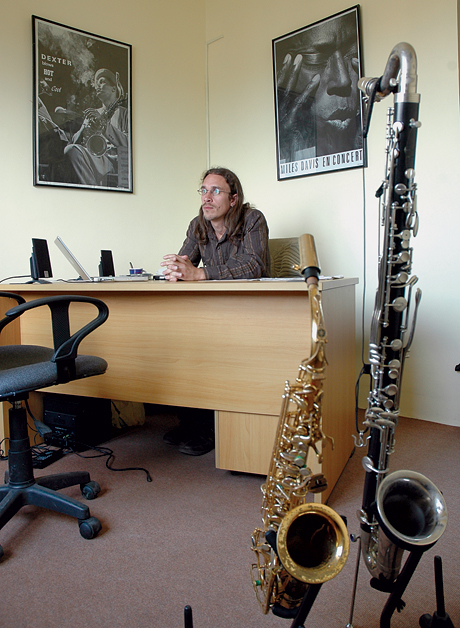Somebody once said: “Do things wholeheartedly”. I found it happening while standing in the corridor amongst passionate musicians and teachers of this school. Yes, a music school, the Kathmandu Jazz Conservatory (KJC).
 KJC is located on the topmost floor of Gyanodaya College, Jhamsikhel. Mariano Abello from Spain, the Principal, appreciated and played flamenco from an early age and found his way to Nepal two years ago. With jazz in his heart, he met other two noted Nepali musicians: Nirakar Yaktumba and Manoj K.C. They shared his passion, and together planned to open a jazz conservatory. The faculty is professional players and educators from abroad and from great Nepali music bands such as Cadenza, Stupa and 1974 AD. “Our main focus is teaching Nepali people the core of music and jazz. There is a lot of talent here, but they have not had
KJC is located on the topmost floor of Gyanodaya College, Jhamsikhel. Mariano Abello from Spain, the Principal, appreciated and played flamenco from an early age and found his way to Nepal two years ago. With jazz in his heart, he met other two noted Nepali musicians: Nirakar Yaktumba and Manoj K.C. They shared his passion, and together planned to open a jazz conservatory. The faculty is professional players and educators from abroad and from great Nepali music bands such as Cadenza, Stupa and 1974 AD. “Our main focus is teaching Nepali people the core of music and jazz. There is a lot of talent here, but they have not had
opportunities like elsewhere,’ says Mariano.
Each practice room allocated to a separate set of instruments, is sound proofed. There are also rooms for vocal training, group practice, a music hall seating 200 people, a music library, a state-of-the-art recording studio for commercial recording as well as to learn the art of recording, and the principal’s office where we heard the sound of jazz flowing. The curriculum, which is the same as Mariano was teaching at Florida Atlantic University in the USA, is designed for students to become competitive musicians in Nepal or anywhere in the world. The course certifies students with two or three year diplomas. Theory classes are complemented by practicals. Students of any age (starting from age three) and of any musical ability can join the school. They are organized into ensembles to gain proficiency in ensemble playing and improvisation. There are saxophones, flutes, clarinets, guitars, drums, pianos and various percussion instruments to choose from, and ensembles of jazz, blues, funk, rock, and classical.
Jazz is an extremely flexible form of music. It can be improvised with anything and the result is a fusion of jazz with a different music. In Mariano, I found both a musician talking about his passion for jazz and a principal of the school informing me on the seriousness of their efforts. I am also informed about their goal to create a unique atmosphere for music students in Nepal to socialize, and meet other musicians. Dedication on the parts of the students is vital. The registered students can practice as long as they want but must maintain the facilities in good condition and not loiter around aimlessly.
He remembers his childhood, growing up listening to his mothers’ records. Unlike other beginners of his age, he developed affection for traditional Spanish music, especially the flamenco. In the same decade, the Gypsies were mixing flamenco with modern music. This raised a curiosity in people to learn the roots of Spanish music. He tells me that youth in Spain today are mostly seen playing their traditional music. He says the same for Nepali music: That the authentic old tunes have a place of their own. Nepali music alone, or if mixed with other music like jazz, is unique in its own way.
Every tune, song or musician has a story to tell. Even these school musicians have a story to relate—to create a space for music lovers and learners, to teach music, and to nurture talents that are beginning to blossom in Nepal.










